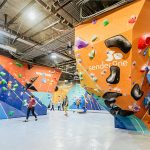The old expression “everything old is new again” rings true for the upcoming year’s trends in fitness, according to a new survey released by the American College of Sports Medicine. In ACSM’s annual worldwide survey of fitness trends, body weight training – which includes back-to-basics exercises like push-ups, planks, pull-ups, squats and other exercises which use the body as resistance – appears in the top 10 for the first time.
“Body weight exercises are a proven way to get and stay fit.” said Walt Thompson Ph.D., FACSM, of Georgia State University, who authored the study. “In a time when many people are concerned with cutting expenses, body weight exercises are a great way to feel great and look toned without a big financial investment.”
In addition to adding body weight training as a new trend for 2013, this year’s survey supports some of the previous trends and re-established two trends from previous surveys. Pilates, balance training, and the stability ball are trends that previously been listed in the top 20 but have not re-appeared on the list after they dropped off the list a couple of years ago.
The survey, now in its seventh year, was completed by 3,346 health and fitness professionals worldwide (certified by ACSM and other organizations) and was designed to reveal trends in various fitness environments. Thirty-seven potential trends were given as choices, and the top 20 were ranked and discussed in the survey report. The trends research is a much-anticipated annual feature of ACSM’s Health & Fitness Journal®.
The top ten fitness trends predicted for 2013 are:
1. Educated, Certified and Experienced Fitness Professionals: Educated and experienced fitness professionals claimed the top spot in 2013 for the sixth consecutive year. Fully accredited education and certification programs for health/fitness professionals are on the rise. There seems to be an exponential growth of educational programs at community colleges, undergraduate programs, and graduate programs at colleges and universities, which have become accredited by the Commission on Accreditation of Allied Health Education Programs through the Committee on Accreditation for the Exercise Sciences and more certification programs accredited by the National Commission for Certifying Agencies. The importance of obtaining certification through academic accreditation is highly recognized by the fitness industry.
2. Strength Training: Remaining in the #2 spot for the second year in a row, this trend is important for men, women, young and old to improve or maintain strength. Most health and fitness professionals today incorporate strength training into a comprehensive exercise routine for their clients and for patients with stable diseases.
3. Body Weight Training: This is the first appearance of this trend in the survey. Body weight training uses minimal equipment making it more affordable. Not just limited to push-ups and pull-ups this trend allows people to get “back to the basics” with fitness.
4. Children and Obesity: The epidemic of overweight or obesity in children continues to be a serious public health problem. Schools have an emphasis on scholastic achievement limiting the time spent on physical education and nutrition programming. The primary source of physical activity for kids could fall into the hands of the health/fitness industry along with fitness professionals. Corporate and clinical programs also may see this as an opportunity to develop specialized physical activity programs for children of their staff and clients.
5. Exercise and Weight Loss: Incorporating diet and exercise, increasing caloric expenditure and decreasing caloric intake, is of growing interest among fitness professionals. More and more of these professionals are finding the need to be able to provide the right fitness program to balance the energy expenditure/energy consumption scale.
6. Fitness Programs for Older Adults: The baby boom generation is growing older and living longer. Physicians are recommending that these patients enroll in some form of physical activity, thus more opportunities for physical fitness are being provided. Since this group typically has more discretionary money and time than others, fitness clubs should be capitalizing on this market. Fitness professionals should develop programs for the highly active older adult (the athletic old) with more rigorous activities and for the less active adult with more of an emphasis on functional fitness.
7. Personal Training: Personal trainers are accessible to more people in all areas of health and fitness through employment in community-based programs, commercial settings, corporate wellness programs and medical fitness programs. More attention is being paid to the education and certification of trainers.
8. Functional Fitness: Functional fitness uses strength training to improve balance, coordination, and endurance in order to participate in daily activities without any stress. This fitness program is designed to reflect the actual activities the client performs throughout any given day. Often times this program is created for older adults.
9. Core Training: Core training stresses strength and conditioning of the stabilizing muscles of the abdomen, thorax, and back. It typically includes exercises of the hips, lower back, and abdomen, all of which provide support for the spine and thorax. Exercising core muscles improves overall stability of the trunk and transfers that to the extremities, enabling the individual to meet the demands for activities of daily living and sports performance.
10. Group Personal Training: This trend allows the personal trainer to provide individualized service catered to small groups of two to four people. Due to the economic times both trainer and client have needed to come up with different options for personalized training on a budget. This allows groups to have a discounted rate, while still giving the trainer a full schedule of clients.
The full list of top 20 trends is available in the article “Worldwide Survey of Fitness Trends for 2013.”
As the holidays approach, interest in health and fitness resolutions builds. Adding to the urgency is the alarming U.S. epidemic of obesity and physical inactivity, with research continuing to underscore the relationship between exercise and health. Those seeking to help people of all ages and conditions become and remain physically active look to ACSM research for evidence-based recommendations.
The American College of Sports Medicine is the largest sports medicine and exercise science organization in the world. More than 45,000 international, national and regional members and certified professionals are dedicated to advancing and integrating scientific research to provide educational and practical applications of exercise science and sports medicine.














